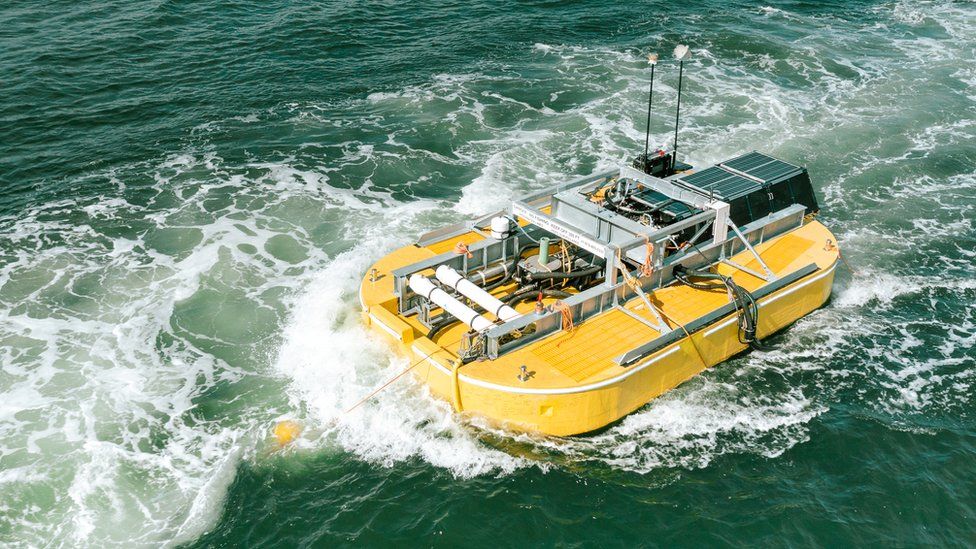ARTICLE AD BOX
 Image source, Gareth Leah
Image source, Gareth Leah
Oneka Technologies makes floating desalination systems that are solely powered by the movement of waves
By Katherine Latham
Business reporter
"The ocean is an unforgiving place," says Susan Hunt. "But our technology is designed to operate there - it goes up and down in the waves, all day and all night."
Ms Hunt is chief innovation officer for a Canadian start-up called Oneka Technologies. It has developed floating desalination systems that turn seawater into fresh water.
While large, shore-based desalination plants typically require vast amounts of energy to remove the salt, Oneka's small units are powered solely by the movement of the waves.
"Desalination facilities are conventionally powered by fossil fuels," says Ms Hunt. "But the world has certainly reached a pivot point. We want to move away from fossil fuel powered desalination."
More than 300 million people around the world now rely on desalinated water, according to the global trade body, the International Desalination Association. This water is supplied by more than 21,000 plants, almost twice as many as there were 10 years ago.
Demand for such plants is likely to grow further, as the world population grows and climate change continues to put pressure on fresh water supplies.
Image source, Oneka
Image caption,Susan Hunt says that Oneka's system is scalable, and that multiple units can be anchored next to each other
At least half of the world's population "live under highly water-stressed conditions for at least one month of the year", according to one report published earlier this year. Meanwhile, a 2020 study said the desalination sector would grow by 9% each year between now and 2030.
There are currently two techniques used to desalinate seawater - thermal and membrane. In thermal-based desalination, seawater is heated until it evaporates, leaving the salt behind. It is typically very energy intensive.
The membrane-based system, also known as reverse osmosis, works by pushing saltwater through a semi-permeable membrane, which catches the salt. This still requires a significant amount of energy, but less so than thermal.
In both cases, the energy supply more often doesn't come from renewable sources or nuclear, and so contributes to carbon dioxide emissions.
Each technique also produces a waste stream of highly concentrated salt water or brine. If this is not properly diluted before being discharged back into the sea, then it can create "dead zones" - areas where the salt levels are too high to support marine life.
Oneka's floating desalination machines - buoys anchored to the seabed - use a membrane system that is solely powered by the movement of the waves.
The buoys absorb energy from passing waves, and covert it into mechanical pumping forces that draw in seawater and push around a quarter of it through the desalination system. The fresh, drinking water is then pumped to land through pipelines, again only using the power provided by the waves.
"The tech uses no electricity," says Ms Hunt. "It is 100% mechanically driven."
The units require just one metre high waves to work, and the firm hopes that it will start to sell them commercially next year. They come in three sizes, the largest of which is 8m long by 5m wide, and can produce up to 49,000 litres (13,000 US gallons) of drinking water per day.
The brine that is produced is mixed back in with the three quarters of seawater that the buoys pull in but hasn't gone through the membrane. This is then released back into the sea. "It's only about 25% saltier than the original sea water," says Ms Hunt. "It's a much lower concentration of brine compared to traditional desalination methods."
She adds that Oneka's system is modular - multiple buoys can be anchored beside each other - and that it is marine-life friendly.
In the Netherlands, Dutch firm Desolenator has a different approach to using renewable energy to power desalination - it uses solar panels.
Image source, Desolenator
Image caption,Desolenator's desalination plant are all solar powered
The heat and electrical energy these collect is used to power a thermal evaporation system. Any electricity not immediately used is stored in batteries, while excess heat is kept in hot water tanks. This results in an uninterrupted energy supply, meaning that the desalination can continue through the night.
Desolenator also does not release any brine back into the sea. Instead it collects all the salt for commercial use.
"Brine has long been a headache in desalination," says Lauren Beck, the firm's head of projects. "Essentially it's a waste product. We crystallise the brine to produce high value salt.
"And because we don't use any harmful chemicals this is a very pure, high quality salt that can we sold for any kind of industrial use. This is really focusing on the circular economy approach."
New Tech Economy is a series exploring how technological innovation is set to shape the new emerging economic landscape.
Louise Bleach, Desolenator's vice president of business development, adds that global shortages of fresh water are making it ever more valuable. "You hear people talking about water like it's the next oil," she says.
Chedly Tizauoi, a professor of chemical engineering at Swansea University, is an expert on water supply and treatment systems. While he welcomes developments in desalination systems powered solely by renewable energy, he says everyone should focus on using less water in the first place.
"Use less water, only when you need it," he says. "The energy needed to pump water, the chemicals used to treat it. These are important considerations when turning on the tap."

 1 year ago
30
1 year ago
30








 English (US) ·
English (US) ·